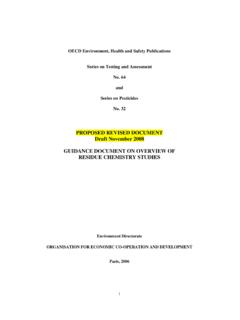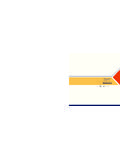Transcription of The Hershberger Bioassay in Rats - OECD.org
1 DRAFT OECD GUIDELINE FOR THE TESTING OF 1 CHEMICALS 2 The Hershberger Bioassay in Rats 3 INTRODUCTION 4 1. The OECD initiated a high-priority activity in 1998 to revise existing guidelines and to 5 develop new guidelines for the screening and testing of potential endocrine disrupters (1). One 6 element of the activity was to develop a test guideline for the rat Hershberger Bioassay . After 7 several decades of use by the pharmaceutical industry, this assay was first validated by an 8 official expert committee in 1962 as a screening tool for androgenic chemicals (2). Over the last 9 five years, the rat Hershberger Bioassay has undergone an extensive validation program 10 including the compilation of a detailed methods paper (3), dissection guide and the conduct of 11 extensive intra- and interlaboratory studies to show the reliability and reproducibility of the 12 Bioassay with a potent reference androgen (testosterone propionate (TP)), two potent synthetic 13 androgens (trenbolone acetate and methyl testosterone), a potent antiandrogenic pharmaceutical 14 (flutamide), a potent inhibitor of a natural androgen (dihydrotestosterone-DHT) synthesis 15 (finasteride), several weakly antiandrogenic pesticides (linuron, vinclozolin, procymidone, p,p 16 DDT), a potent 5 alpha reductase inhibitor (finasteride) and two known negative chemicals 17 (dinitrophenol and nonylphenol (4)(5)(6)(7)(8))
2 This Test Guideline XXX is the outcome of the 18 long historical experience with the Bioassay and the experience gained during the validation test 19 programme and the results obtained thereby. 20 21 2. The Hershberger Bioassay is a short-term screening test that originated in the 1930 s 22 using accessory tissues of the male reproductive tract and modified in the 1940 s to include 23 androgen-responsive muscles in the male reproductive tract (2)(9-16). In the 1960s, a 24 standardized protocol was used to evaluate over 700 possible androgens (2)(14), and the assay s 25 use for both androgens and antiandrogens was considered a standard method in the 1960s 26 (2)(15)(16). The current Bioassay is based on the changes in weight of five androgen-dependent 27 tissues in the castrate-peripubertal male rat. It evaluates the ability of a chemical to elicit 28 biological activities consistent with androgen agonists or antagonists.
3 The five androgen-29 dependent tissue included in the Test Guideline XXX are the ventral prostate (VP), seminal 30 vesicle (SV) (plus fluids and coagulating glands), levator ani-bulbocavernosus (LABC) muscle, 31 paired Cowper s glands (COW) and the glans penis (GP). In the castrate-peripubertal male rat, 32 these five tissues all respond to androgens with an increase in absolute weight. When these same 33 tissues are stimulated to increase in weight by administration of a potent reference androgen, 34 these five tissues all respond to antiandrogens with a decrease in absolute weight. 35 36 3. This Bioassay serves as an in vivo screening assay for androgens and antiandrogens and 37 its application should be seen in the context of the OECD Conceptual Framework for the 38 Testing and Assessment of Endocrine Disrupting Chemicals.
4 In this Conceptual Framework the 39 Hershberger Bioassay is contained in Level 3 as an in vivo assay providing data about a single 40 endocrine mechanism, (anti)androgenicity. 41 42 4. The Hershberger Bioassay is an in vivo screening assay embedded within a battery of 43 tests ultimately leading to hazard and risk assessments for human health or the environment. As 44 for all screening assays it should not fail to identify chemicals with intrinsic (anti)androgenic 45 activity (no false negatives), while a low rate of false positives may be allowed for. The above 46 mentioned OECD validation program demonstrated sensitivity of the test procedure for 47 antagonists and agonists as well as good intra- and interlaboratory reproducibility, and 48 demonstrated a low rate of false positives with two negative compounds. 49 50 INITIAL CONSIDERATIONS AND LIMITATIONS 51 5.
5 Androgen agonists and antagonists act as ligands for the androgen receptor and may 52 activate or inhibit, respectively, gene transcription controlled by the receptor. In addition, some 53 chemicals inhibit the conversion of testosterone to the more potent natural androgen 54 dihydrotestosterone in some androgen target tissues (5 -reductase inhibitors). Such substances 55 have the potential to lead to adverse health hazards, including reproductive and developmental 56 effects. Therefore, the regulatory need exists to rapidly assess and evaluate a chemical as a 57 possible androgen agonist or antagonist or 5 -reductase inhibitor. While informative, the 58 affinity of a ligand for an androgen receptor or transcriptional activation of reporter genes in 59 vitro are not the only determinants of possible hazard. Other determinants include metabolic 60 activation and deactivation upon entering the body, substance distribution to target tissues, and 61 clearance from the body.
6 This leads to the need to screen the possible activity of a chemical in 62 vivo under relevant conditions and exposure, unless the chemical s characteristics regarding 63 Absorption Distribution Metabolism Elimination (ADME) are known. Androgen-64 dependent tissues respond with rapid and vigorous growth to stimulation by androgens, 65 particularly in castrate-peripubertal male rats. Rodent species, particularly the rat, are also 66 widely used in toxicity studies for hazard characterization. Therefore, the rat and these five 67 target tissues in this assay are appropriate for the in vivo screening of androgen agonists and 68 antagonists and 5 -reductase inhibitors. 69 70 6. This Guideline is based on those protocols employed in the OECD validation study 71 which have been shown to be reliable and repeatable in intra- and interlaboratory studies 72 (4)(5)(6)(7)(8).
7 73 74 7. Although there was some variation in the dose of TP used to detect antiandrogens in the 75 OECD Hershberger Bioassay validation program by the different laboratories ( versus 76 mg/kg/d sc) there was little difference between these two protocol variations in the ability to 77 detect weak or strong antiandrogenic activity. However, it is clear that the dose of TP should not 78 be too high as to block the effects of weak androgen receptor (AR) antagonists or so low that the 79 androgenic tissues display little growth response even without antiandrogen coadministration. 80 81 8. The growth response of the individual androgen-dependent tissues is not entirely of 82 androgen origin, compounds other than androgen agonists can alter the weight of certain 83 tissues. The growth response of several tissues is then more specific.
8 For example, high doses 84 of potent estrogens can increase the weight of the seminal vesicles. However, the other 85 androgen-dependent tissues in the assay do not respond in a similar manner. Antiandrogenic 86 chemicals can act either as androgen receptor antagonists or 5 -reductase inhibitor. 5 -87 reductase inhibitors have a variable affect, because the conversion to more potent 88 dihydrotestosterone varies by tissue. For example, the VP is relatively dependent on 5 -89 reductase activity, and the LABC is much less so. In addition, the androgen receptor is 90 evolutionarily related to other steroid hormones, and some other hormones, when administered at 91 high, supraphysiological dosage levels, can bind and antagonize the growth-promoting effects of 92 TP. Further, it also is plausible that enhanced steroid metabolism and a consequent lowering of 93 serum testosterone could reduce androgen-dependent tissue growth.
9 Therefore, any positive 94 outcome in the Hershberger Bioassay should normally be evaluated using a weight of evidence 95 approach, including in vitro assays, such as the AR and ER binding assays and corresponding 96 transcriptional activation assays, or from other in vivo assays such as similar androgen target 97 tissues in the male pubertal assay and 91-day repeat dose studies. 98 99 9. Experience indicates that xenobiotic androgens are rare and that xenobiotic antiandrogens 100 are more common. The expectation then is that the Hershberger Bioassay will be used most 101 often for the screening of androgen antagonists. However, the procedure to test for androgens 102 could, nevertheless, be recommended for steroidal or steroid-like chemicals or for chemicals for 103 which an indication of possible androgenic effects was derived from in-development methods 104 contained in level 1 or 2 of the conceptual framework.
10 Similarly, adverse effects associated with 105 (anti)androgenic profiles may be observed in level 5 assays, leading to the need to assess whether 106 a substance operates by an endocrine mode of action. 107 108 10. It is acknowledged that all animal based procedures will conform to local standards of 109 animal care; the descriptions of care and treatment set forth below are minimal performance 110 standards, and will be superseded by local regulations. Further guidance of the humane treatment 111 of animals is given by the OECD (17). 112 113 11. Definitions used in this Test Guideline are given in ANNEX 1. 114 115 PRINCIPLE OF THE TEST 116 12. The Hershberger Bioassay achieves its sensitivity by using castrated males and providing 117 adequate time after castration for the target tissues to regress to a minimal and uniform baseline 118 weight.
















